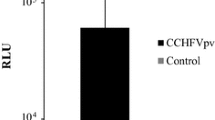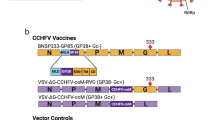Abstract
Crimean-Congo hemorrhagic fever (CCHF) is a tick-borne disease with a mortality rate of up to 50% in humans. To avoid safety concerns associated with the use of live virus in virus neutralization assays and to detect human serum neutralizing antibodies, we prepared lentiviral particles containing the CCHF glycoprotein (lenti-CCHFV-GP). Incorporation of the GP into the lentiviral particle was confirmed by electron microscopy and Western blotting. Lenti-CCHFV-GP was found to be able to infect a wide range of cell lines, including BHK-21, HeLa, HepG2, and AsPC-1 cells. In addition, lenti-CCHFV-GP was successfully used as an alternative to CCHFV for the detection of neutralizing antibodies. Sera collected from CCHF survivors neutralized lenti-CCHFV-GP particles in a dose-dependent manner. Our results suggest that the lenti-CCHFV-GP pseudovirus can be used as a safe tool for neutralization assays in low-containment laboratories.








Similar content being viewed by others
References
Ahani R, Roohvand F, Cohan RA, Etemadzadeh MH, Mohajel N, Behdani M, Shahosseini Z, Madani N, Azadmanesh K (2016) Sindbis virus-pseudotyped lentiviral vectors carrying VEGFR2-specific nanobody for potential transductional targeting of tumor vasculature. Mol Biotechnol 58:738–747
Al Abaidani I, Fazlalipour M, Mostafavi E, Leblebicioglu H (2017) Current status of Crimean-Congo hemorrhagic fever in WHO Eastern Mediterranean Region: issues, challenges and future directions. Int J Infect Dis 58:82–89
Barde I, Salmon P, Trono D (2010) Production and titration of lentiviral vectors. Curr Protoc Neurosci 53:21–24
Bastug A, Kayaaslan B, But A, Aslaner H, Sertcelik A, Akinci E, Onguru P, Yetkin MA, Bodur H (2014) A case of Crimean-Congo hemorrhagic fever complicated with acute pancreatitis. Vector Borne Zoonotic Dis 14:827–829
Bente DA, Forrester NL, Watts DM, McAuley AJ, Whitehouse CA, Bray M (2013) Crimean-Congo hemorrhagic fever: history, epidemiology, pathogenesis, clinical syndrome and genetic diversity. Antiviral Res 100:159–189
Berber E, Canakoglu N, Yoruk MD, Tonbak S, Aktas M, Ertek M, Bolat Y, Kalkan A, Ozdarendeli A (2013) Application of the pseudo-plaque assay for detection and titration of Crimean-Congo hemorrhagic fever virus. J Virol Methods 187:26–31
Brindley MA, Hunt CL, Kondratowicz AS, Bowman J, Sinn PL, McCray PB Jr, Quinn K, Weller ML, Chiorini JA, Maury W (2011) Tyrosine kinase receptor Axl enhances entry of Zaire ebolavirus without direct interactions with the viral glycoprotein. Virology 415:83–89
Canakoglu N, Berber E, Tonbak S, Ertek M, Sozdutmaz I, Aktas M, Kalkan A, Ozdarendeli A (2015) Immunization of knock-out α/β interferon receptor mice against high lethal dose of Crimean-Congo hemorrhagic fever virus with a cell culture based vaccine. PLoS Negl Trop Dis 9:e0003579
Carnell GW, Ferrara F, Grehan K, Thompson CP, Temperton NJ (2015) Pseudotype-based neutralization assays for influenza: a systematic analysis. Front Immunol 6:161
Casals J, Tignor GH (1980) The Nairovirus genus: serological relationships. Intervirology 14:144–147
Cifuentes-Muñoz N, Darlix J-L, Tischler ND (2010) Development of a lentiviral vector system to study the role of the Andes virus glycoproteins. Virus Res 153:29–35
Hoogstraal H (1979) The epidemiology of tick-borne Crimean-Congo hemorrhagic fever in Asia, Europe, and Africa. J Med Entomol 15:307–417
Klimov A, Balish A, Veguilla V, Sun H, Schiffer J, Lu X, Katz JM, Hancock K (2012) Influenza virus titration, antigenic characterization, and serological methods for antibody detection. Methods Mol Biol 865:25–51
Kondratowicz AS, Lennemann NJ, Sinn PL, Davey RA, Hunt CL, Moller-Tank S, Meyerholz DK, Rennert P, Mullins RF, Brindley MJ (2011) T-cell immunoglobulin and mucin domain 1 (TIM-1) is a receptor for Zaire ebolavirus and Lake Victoria Marburgvirus. Proc Natl Acad Sci USA 108(8426–843):8431
Leblebicioglu H (2010) Crimean-Congo haemorrhagic fever in Eurasia. Int J Antimicrob Agents 36:S43–S46
Li Qianqian, Liu Qiang, Huang Weijin, Li Xuguang, Wang Youchun (2018) Current status on the development of pseudoviruses for enveloped viruses. Rev Med Virol 28:e1963
Li Y, Zhao Y, Wang C, Zheng X, Wang H, Gai W, Jin H, Yan F, Qiu B, Gao Y (2018) Packaging of Rift Valley fever virus pseudoviruses and establishment of a neutralization assay method. J Vet sci 19:200–206
Liu H, Wu R, Yuan L, Tian G, Huang X, Wen Y, Ma X, Huang Y, Yan Q, Zhao Q (2017) Introducing a cleavable signal peptide enhances the packaging efficiency of lentiviral vectors pseudotyped with Japanese encephalitis virus envelope proteins. Virus Res 229:9–16
Marriott AC, Polyzoni T, Antoniadis A, Nuttall PA (1994) Detection of human antibodies to Crimean-Congo haemorrhagic fever virus using expressed viral nucleocapsid protein. J Gen Virol 75:2157–2161
Mazzola LT, Kelly-Cirino C (2019) Diagnostic tests for Crimean-Congo haemorrhagic fever: a widespread tick borne disease. BMJ Glob Health 4:e001114
Messina JP, Pigott DM, Golding N, Duda KA, Brownstein JS, Weiss DJ, Gibson H, Robinson TP, Gilbert M, William Wint G (2015) The global distribution of Crimean-Congo hemorrhagic fever. Trans R Soc Trop Med Hyg 109:503–513
Mild M, Simon M, Albert J, Mirazimi A (2010) Towards an understanding of the migration of Crimean-Congo hemorrhagic fever virus. J Gen Virol 91:199–207
Ergonul O (2007) clinical and pathologic features of Crimean-Congo hemorrhagic fever. In: Ergonul O, Whitehouse CA (eds) Crimean-Congo hemorrhagic fever, vol 8. Springer, Dordrecht, pp 123–124
Mostafavi E, Pourhossein B, Esmaeili S, Amiri FB, Khakifirouz S, Shah-Hosseini N, Tabatabaei SM (2017) Seroepidemiology and risk factors of Crimean-Congo hemorrhagic fever among butchers and slaughterhouse workers in southeastern Iran. Int J Infect Dis 64:85–89
Ray N, Whidby J, Stewart S, Hooper JW, Bertolotti-Ciarlet A (2010) Study of Andes virus entry and neutralization using a pseudovirion system. J Virol Methods 163:416–423
Rodriguez SE, Cross RW, Fenton KA, Bente DA, Mire CE, Geisbert TW (2019) Vesicular stomatitis virus-based vaccine protects mice against Crimean-Congo hemorrhagic fever. Sci Rep 9:7755
Sinn PL, Coffin JE, Ayithan N, Holt KH, Maury W (2017) Lentiviral vectors pseudotyped with filoviral glycoproteins. Methods Mol Biol 1628:65–78
Suda Y, Fukushi S, Tani H, Murakami S, Saijo M, Horimoto T, Shimojima M (2016) Analysis of the entry mechanism of Crimean-Congo hemorrhagic fever virus, using a vesicular stomatitis virus pseudotyping system. Arch Virol 161:1447–1454
Suda Y, Chamberlain J, Dowall S, Saijo M, Horimoto T, Hewson R, Shimojima M (2018) The development of a novel diagnostic assay that uses a pseudotyped vesicular stomatitis virus for the detection of neutralising activity to Crimean-Congo haemorrhagic fever virus. Jpn J Infect Dis 2017:2354
Ward VK, Marriott AC, Polyzoni T, El-Ghorr AA, Antoniadis A, Nuttall PA (1992) Expression of the nucleocapsid protein of Dugbe virus and antigenic cross-reactions with other nairoviruses. Virus Res 24:223–229
Weidmann M, Avsic-Zupanc T, Bino S, Bouloy M, Burt F, Chinikar S, Christova I, Dedushaj I, El-Sanousi A, Elaldi N (2016) Biosafety standards for working with Crimean-Congo haemorrhagic fever virus. J Gene Virol 97:2799–2808
WHO (2017) R&D Blueprint for action to prevent epidemics. http://www.who.int/blueprint/en/ . Accessed 12 Sep 2017
Yadav PD, Pardeshi PG, Patil DY, Shete AM, Mourya DT, Joi J, Health P (2019) Persistence of IgG antibodies in survivors of Crimean Congo hemorrhagic fever virus infection, India. J Infect Public Health 12:598–599
Zivcec M, Scholte F, Spiropoulou C, Spengler J, Bergeron É (2016) Molecular insights into Crimean-Congo hemorrhagic fever virus. Viruses 8:106
Zivcec M, Guerrero LI, Albariño CG, Bergeron É, Nichol ST, Spiropoulou CF (2017) Identification of broadly neutralizing monoclonal antibodies against Crimean-Congo hemorrhagic fever virus. Antiviral Res 146:112–120
Acknowledgements
The authors wish to thank all colleagues in the Department of Arboviruses and Viral Hemorrhagic Fevers at the Pasteur Institute of Iran for cooperation and excellent technical assistance. We gratefully acknowledge Gary Kobinger for scientific comments during manuscript preparation.
Funding
This research was part of a PhD thesis supported by Tehran University of Medical Sciences (Grant no. 96-04-27-36866).
Author information
Authors and Affiliations
Contributions
AAV and MSV designed and organized the study. AAV, KA, AN, MHP, MMG and MP contributed to the planning, designing and analysis of the experiments, and data collection. AAV performed the statistical analysis. AAV, SS and MSV provided materials and analysis tools. AAV, MSV, KA and SS wrote and critically revised the manuscript. All authors read and approved the final manuscript.
Corresponding author
Ethics declarations
Conflict of interest
All authors declare that they have no conflict of interest.
Ethical approval
All procedures involving human patients were performed in accordance with the ethical standards of the Ethical Committee of Tehran University of Medical Science (Ethical Code No: 96-04-27-36866).
Informed consent
Informed consent was obtained from all individual participants included in the study.
Additional information
Handling Editor: Hideki Ebihara.
Publisher's Note
Springer Nature remains neutral with regard to jurisdictional claims in published maps and institutional affiliations.
Electronic supplementary material
Below is the link to the electronic supplementary material.
Rights and permissions
About this article
Cite this article
Vasmehjani, A.A., Salehi-Vaziri, M., Azadmanesh, K. et al. Efficient production of a lentiviral system for displaying Crimean-Congo hemorrhagic fever virus glycoproteins reveals a broad range of cellular susceptibility and neutralization ability. Arch Virol 165, 1109–1120 (2020). https://doi.org/10.1007/s00705-020-04576-9
Received:
Accepted:
Published:
Issue Date:
DOI: https://doi.org/10.1007/s00705-020-04576-9




